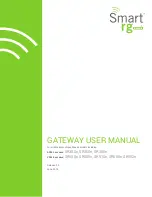
30
www.cooperbussmann.com/wirelessresources
Cooper Bussmann 245U-E Wireless Ethernet Modem & Device Server User Manual
Rev Version 2.19
An 802.1x capable RADIUS server may already be deployed in a large scale network environment. The 245U-E
can make use of this server reducing replication of user authentication information.
In a typical WPA-enterprise setup, the 245U-E access point acts as Authenticator, controlling access to the
network. Wireless clients (245U-Es, laptops or other devices) act as Supplicants, requesting access to the
network. The Authenticator communicates with an authentication (RADIUS) server on the Ethernet network to
verify Supplicant identity. When a Supplicant requests access, it sends an access request to the Authenticator,
which passes an authentication request to the external authentication server. When the user credentials of the
Supplicant are verified, the Authenticator enables network access for the Supplicant, data encryption keys are
established and network traffic can pass.
Configuration of WPA-enterprise differs when the unit is configured as an access point (Authenticator) or client
(Supplicant). If WDS interfaces are used, it is possible for one 245U-E to act as both an Authenticator and a
Supplicant, but in this situation only one set of user credentials can be entered for all Supplicants.
The 245U-E supports WPA-1 TKIP, WPA-1 AES and WPA-2 AES using a pre-shared key (PSK).
•
WPA PSK (TKIP)
(Temporal Key Integrity Protocol) enhances WEP by using 128-bit encryption plus separate
64-bit TX and RX MIC (message integrity check) keys.
•
WPA PSK (AES)
(Advanced Encryption Standard) uses the more advanced CCMP encryption protocol and is
essentially a draft of the IEEE 802.11i wireless network standard. This is the recommended encryption method
in most applications.
•
WPA2 AES
(Advanced Encryption Standard) is the most secure encryption method and is also based on
128-bit encryption key.
After changes are made to Network Configuration, it is important to save the configuration by clicking Save
Changes or by selecting Save Changes and Reset.
Network Settings Webpage Fields
Operating Mode
Used to select Access Point (Infrastructure), Client (Infrastructure). By default this is
set to Client.
System Address
(ESSID)
A 245U-E wireless network comprises modules with the same system address.
Only modules with the same system address will communicate with each other. The
system address is a text string 1 to 31 characters long. Select a text string which
identifies your system.
Desired BSSID
To force a client/station to always connect to the same access point, enter the MAC
address of that access point in the Desired BSSID field. Note that the ESSID of the
access point must also match the configured ESSID of the client.
Radio Encryption
Select the desired radio encryption level. The encryption key, passphrase and other
security information is entered on the Security menu. See “3.7 Security Menu” for
details.
Device Mode
Used to select Bridge or Router mode. By default this is set to Bridge. If VLAN is
enabled, the Device Mode will indicate “VLAN” and the IP address and netmask will
only be editable from the VLAN page.
Bridge STP
Checking this box enables Spanning Tree Protocol in bridged networks.
See “3.5 Spanning Tree Algorithm” for details.
Obtain IP Address
Automatically
Selecting this option enables DHCP client on the 245U-E. A DHCP client requests
its IP address from a DHCP server which assigns the IP address automatically. For
more information, see “3.21 DHCP Server Configuration.” By default this option is
not selected.















































